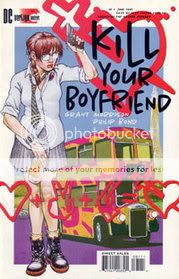Kill Your Boyfriend
Grant Morrison, writer
Philip Bond, artist
DC/Vertigo, 1995
62 pages
$5.95
Buy it used for, like, $40 from Amazon.com
There was a time, circa the moment in high school when I nicknamed my then-girlfriend’s breasts Mickey and Mallory, when I would have thought this astonishingly earnest encomium to the liberation of smart high-schoolers via sex, drugs, violence, and arty notions of personal identity was the coolest motherfucking book I’d ever read. There have also been times, like the moment I realized how incredibly stupid it was to give that same girlfriend a copy of Sin City bearing the inscription “I’ll be your Marv if you’ll be my Goldie” for her birthday and not expect her to be disturbed by my comparing her to a dead prostitute, that a book like this would have earned sneers of derision and/or waves of nausea from me.
At this particular moment, however, I’m at a Goldilocks-like level of just-right comfort with this comic. Goddess only knows if Grant Morrison intended lines like “The only way to stop being bored is to do something interesting or criminal. These days it comes to the same thing” with a straight face, but viewed from the remove of 14 years Kill Your Boyfriend strike me less as po-faced Warren Ellis-style pop-violent hipsterism and more of an embrace-cum-pastiche of its most ridiculous aspects, an exercise in depicting the mindset of a bored kid who’s too cool for school and too smart for his own good than a demonstration of being embarrassingly trapped in that mindset. Little flourishes throughout the comic point in that self-aware direction: The presence of genuinely transgressive elements, like unwitting incest, that are left on the page to be troubling and never get absolved via the I’m-okay-you’re-okay treatment (a la Alan Moore’s Smax); the seeming acknowledgment via a group of all-talk-no-action art students that this comic itself is all talk and no action; the use of direct address by the teenage-girl protagonist, with word balloons disarmingly replacing narrative captions, to highlight the unreality of the narrative and the comparative cipher nature of the glamorous-criminal boyfriend figure; the fact that the ballyhooed killing spree really only includes two murders (Natural Born Killers or Bonnie and Clyde this isn’t). Even some of the stuff that I think can be read more straightforwardly, like the Girl’s proclamation of her first sexual encounter as “brilliant,” is fine with me, since so was mine, and fuck the bluenose prudery that drums otherwise into everyone’s head.
Of course there’s plenty here that’s kind of a mess. The run-on declamations of everyone’s awesomeness are way too on-the-nose. The Girl’s square original boyfriend is a mess of contradictory character traits–fantasy-geek prurience jars bizarrely with condescending asceticism, and the notion that any teenage guy would turn down actual sex in favor of jerking off is ludicrous on its face. The ending, with its “whoa look out your normal-looking neighbor might be a killcrazy former sex maniac who took E and liked it so watch out you dead-behind-the-eyes wage slave” message was surely just as played out when it was written in 1994 as it is now. And the Vertigo-mandated occlusion of any actual explicitness when it comes to sex is as cringe-inducing as always, given how far they’ll take the violence and how much they pride themselves on being “mature.” But nothing can be too terrible when it’s drawn by Philip Bond, whose Britpop cartooniness couldn’t be more perfect for this material. Overall it’s not a comic I see myself returning to very often, but as a warts-and-all time capsule of what it’s like to be one of Morrison’s archetypal “smart 14-year-olds,” you could do worse.
Tags: comics, comics reviews, Comics Time, reviews

